Home PageAbout MindatThe Mindat ManualHistory of MindatCopyright StatusWho We AreContact UsAdvertise on Mindat
Donate to MindatCorporate SponsorshipSponsor a PageSponsored PagesMindat AdvertisersAdvertise on Mindat
Learning CenterWhat is a mineral?The most common minerals on earthInformation for EducatorsMindat ArticlesThe ElementsThe Rock H. Currier Digital LibraryGeologic Time
Minerals by PropertiesMinerals by ChemistryAdvanced Locality SearchRandom MineralRandom LocalitySearch by minIDLocalities Near MeSearch ArticlesSearch GlossaryMore Search Options
The Mindat ManualAdd a New PhotoRate PhotosLocality Edit ReportCoordinate Completion ReportAdd Glossary Item
Mining CompaniesStatisticsUsersMineral MuseumsClubs & OrganizationsMineral Shows & EventsThe Mindat DirectoryDevice SettingsThe Mineral Quiz
Photo SearchPhoto GalleriesSearch by ColorNew Photos TodayNew Photos YesterdayMembers' Photo GalleriesPast Photo of the Day GalleryPhotography
╳Discussions
💬 Home🔎 Search📅 LatestGroups
EducationOpen discussion area.Fakes & FraudsOpen discussion area.Field CollectingOpen discussion area.FossilsOpen discussion area.Gems and GemologyOpen discussion area.GeneralOpen discussion area.How to ContributeOpen discussion area.Identity HelpOpen discussion area.Improving Mindat.orgOpen discussion area.LocalitiesOpen discussion area.Lost and Stolen SpecimensOpen discussion area.MarketplaceOpen discussion area.MeteoritesOpen discussion area.Mindat ProductsOpen discussion area.Mineral ExchangesOpen discussion area.Mineral PhotographyOpen discussion area.Mineral ShowsOpen discussion area.Mineralogical ClassificationOpen discussion area.Mineralogy CourseOpen discussion area.MineralsOpen discussion area.Minerals and MuseumsOpen discussion area.PhotosOpen discussion area.Techniques for CollectorsOpen discussion area.The Rock H. Currier Digital LibraryOpen discussion area.UV MineralsOpen discussion area.Recent Images in Discussions
Improving Mindat.orgQuestionable "Cyanotrichite" photo of the day
4th Jul 2006 17:41 UTCUwe Kolitsch Manager
Looks more like radiating aggregates of acicular (elongate laths in fact) azurite which are well-known from Lavrion (e.g. http://www.mindat.org/picshow.php?id=10371)

4th Jul 2006 21:19 UTCMarius Utens
marius utens
5th Jul 2006 01:19 UTCAntonio Borrelli Expert
I must admit that the deep blue color is unusual for cyanotrichite but the sprays are so tiny that I can't perform any test on them.
I could try with a drop of HCl to see if causes some fizzing but I'll end up spoiling this TN sized specimen.
I guess we should trust the dealer's label or instead I can delete the photo from the database.
Antonio
5th Jul 2006 06:01 UTCRobert Meyer Manager
In my experience, Cyanotrichite from Lavrion is sometimes atypical--darker blue and more coarsely crystallized--as in your photograph. I did not doubt the identity of your specimen. The other Mindat photographs of Cyanotrichite from the Lavrion district bear that out.
You might still wish to get a single needle off of the specimen, and put a drop
of HCl on it an examine the reaction under the microscope.
Bob
5th Jul 2006 13:56 UTCPeter Andresen Expert
When I saw the nice photo I immediatly paid attention to the odd looking yellow mineral that the cyanothrichite was partly sitting on... Do you have any idea what this is? And if you do, please add this information on the description, it kind of made the picture becoming as nice as it is.
This is a thought I often get looking at pictures here in Mindat, to often are accessory minerals worth mentioning left out of the description. This is sad, because it makes the picture a lot more interesting and informative when it's added...
Could it be an idea for our picture reviewers to have a standard e-mail message requesting such information, when there's obviously some interesting accessories? This of course only when the accessories are known...
Regards
Peter A

5th Jul 2006 14:22 UTCLefteris Rantos Expert
I was thinking of the same thing... It's a light bluish mineral (see the interior of the aggregate) with some kind of tan-whitish surface alteration. However, these light blue crusts and bortyoids from Lavrion are often very difficult to identify. My guess is that it could be some Woodwardite-like mineral, but this is a mere guess.
Maybe Uwe could help a little more here?
Concerning the Cyanotrichite, thera are some azure-blue Cyanotrichites from Lavrion indeed. If it's acicular Azurite, the xls should be very elongated laths, not fine acicular as in Cyanotrichite. But I can't really tell from the photo.
Lefteris.
5th Jul 2006 14:41 UTCAntonio Borrelli Expert
I agree with your suggestion.
I always try to mention in my descriptions all the accessory minerals that can be seen in the pictures but in this case I do not have a clue of what the greenish blob may be.
Antonio
5th Jul 2006 15:33 UTCAntonio Borrelli Expert
http://img151.imageshack.us/my.php?image=picture14us.jpg
Which are your opinions? I think Uwe was right: they don't resemble to cyanotrichite.
Antonio

6th Jul 2006 13:50 UTCMarius Utens
form, I think its also possible serpierite
marius utens
6th Jul 2006 14:03 UTCPeter Andresen Expert
Regards
Peter A
27th Oct 2006 14:39 UTCUwe Kolitsch Manager
http://www.mindat.org/photo-42322.html
I will change
http://www.mindat.org/picshow.php?id=64434
to azurite as well, but keep an explanatory note in the description.
27th Oct 2006 17:15 UTCKnut Eldjarn 🌟 Manager
If Antonio could pry loose a microscopic fragment of the mineral and watch the reaction with HCl in a microscope he could probably distinguish between these two. Azurite would dissolve slowly with the formation of small bubbles of CO2 (depending on the HCl-concentration) - on linarite a white coating of lead-chloride would be formed. This can be a very useful and simple microchemical test.
Knut
28th Oct 2006 00:39 UTCAntonio Borrelli Expert
In the end it is azurite.
Antonio
29th Oct 2006 13:54 UTCPeter Haas
30th Oct 2006 00:09 UTCAntonio Borrelli Expert




Mindat.org is an outreach project of the Hudson Institute of Mineralogy, a 501(c)(3) not-for-profit organization.
Copyright © mindat.org and the Hudson Institute of Mineralogy 1993-2024, except where stated. Most political location boundaries are © OpenStreetMap contributors. Mindat.org relies on the contributions of thousands of members and supporters. Founded in 2000 by Jolyon Ralph.
Privacy Policy - Terms & Conditions - Contact Us / DMCA issues - Report a bug/vulnerability Current server date and time: April 23, 2024 21:52:33
Copyright © mindat.org and the Hudson Institute of Mineralogy 1993-2024, except where stated. Most political location boundaries are © OpenStreetMap contributors. Mindat.org relies on the contributions of thousands of members and supporters. Founded in 2000 by Jolyon Ralph.
Privacy Policy - Terms & Conditions - Contact Us / DMCA issues - Report a bug/vulnerability Current server date and time: April 23, 2024 21:52:33











